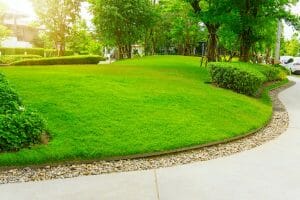There are some simple tricks you can use to take the look of your garden up a notch. One of these tricks is landscape edging. By using the right edging you not only keep your mulch where it belongs but also make your yard look tidy.
 There are a ton of different garden edging techniques out there to choose from. You may want to consider checking in with a design expert from the Ohio Valley Group to see what products would work best for you and your design aesthetic.
There are a ton of different garden edging techniques out there to choose from. You may want to consider checking in with a design expert from the Ohio Valley Group to see what products would work best for you and your design aesthetic.
In this blog, we’ll explore some of the options and some of the more creative techniques that are in style this season. There are pros and cons to each, and the kind of landscape edging you choose will be dependent on the look you are going for and the budget you have for the project.
What Are The Benefits of Landscape Edging?
The primary purpose of landscape edging is to create a clean, crisp barrier between your grass and your garden beds. By using the right materials you will make your yard look well-groomed and pristine.
Landscape edging also helps prevent stray weeds and grass from gaining a foothold amongst your carefully cultivated flowers! There are several factors to consider when making a choice when it comes to landscape edging, including durability, cost, installation challenges, and required maintenance.
What Are Some of The Different Kinds of Edging Styles I Should Consider?
While there are many different kinds of landscaping edging styles and products out there to consider, we’ll discuss four of the most common below.
1. Trench Edging
One of the most natural-looking kinds of edging is trench edging. Trench edging is simply a clean-cut perpendicular edge dug around the perimeter of your garden beds using a shovel, manual rotary, or half-moon edger.
When you mulch the bed, simply slope the mulch downward to create a three-inch trench at the grass line. This has the effect of creating a crisper, cleaner edge than if the mulch is flush with the lawn.
While trench edging is the lowest cost solution and the easiest to create, it has very low durability and will likely only last a season or two. It will require constant vigilance to maintain a clean look.
2. Plastic or Metal Edging
Using a specific product like plastic or metal edging creates a distinct, physical separation between your garden beds and your lawn. You start the process of installing plastic or metal edging as you would with a trench, by digging around the perimeter of your beds.
Once the trench is dug, however, you install a long strip of the edging material of your choice on the border of the grass, making sure it sticks up above ground level. Then fill in behind, and presto, you have a firm, physical separation between your grass and garden.
While plastic or metal edging is relatively low cost and easy to install, if you don’t perform the installation properly you could be left with an unsightly and unattractive mess.
3. Concrete Pavers or Bricks
If you are seeking a more decorative border around your landscaping beds, you should consider installing concrete pavers or bricks. There is a wide variety of colors and styles to choose from that will give your yard just the right look.
You can also choose how they are installed, either raised above the soil or more buried so that they are flush with your lawn. Concrete pavers and bricks are very durable and highly effective against grass creep but are generally higher cost and more difficult to install.
4. Raised Stone Borders
For those who are looking for something more dramatic, something that will make a statement, your best bet is to install a raised stone border around your landscaping beds. The goal of raised borders is to elevate your plants and flowers to the height of the short stone wall that surrounds them.
Not only is lifting your flowers around 12 inches off the ground aesthetically pleasing, but it also saves you from the necessity of bending down and crouching while you tend to your flower beds!
Raised stone borders have some significant pros, like their visually striking nature and prevention of grass creep. They are also ideally suited for sloped yards and landscaped. However, they are the highest cost option and may not be suitable for your existing flower beds. They’ll also more likely than not require professional installation.
How Do I Get Started With My Landscape Edging?
Landscape edging is a great and relatively easy way to dramatically increase the look of your yard, as well as to highlight all of the efforts that you’ve put into it!
Give us a call at the Ohio Valley Group for design advice and a free estimate on what you need to do to take your landscaping to the next level.
